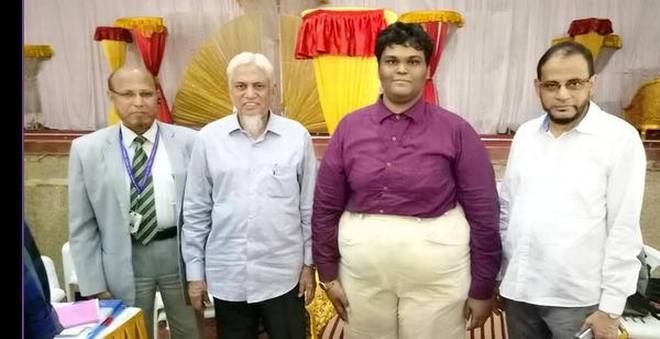Pallapatti / Chennai , TAMIL NADU :

Mohamed Rifath has just joined a physics undergraduate course at New College, but his classmates and teachers are seeing him as a star scientist. Read on and find out why
Can you imagine a fresher receiving a rousing welcome at his college, on the day of joining? When Mohamed Rifath Shaarook Raaj recently joined the B.Sc Physics stream of New College, he was being accorded a reception befitting a celebrity. Not only that, the secretary and correspondent of the college, A. Mohammed Ashraf, had waived off his fee for the undergraduate course, and also promised that the college would take care of his education till he completed his Ph.D.
Rifath, 18 years old, is the Lead Scientist of Space Kidz India (SKI), a Chennai-based organisation promoting students’ research in science and working towards making science accessible to students. Rifath is part of a team that has designed a satellite, which is expected to be launched into space on 21 June, 2017 from the NASA Wallops Space Flight Facility, Virginia, at no cost.
Major Zahid Husain, principal of the college, said that fellow students should emulate this young scientist and that it was a great honour for the college to enrol him. The student scientist has not only taken the local educationalists by storm but even the judges and directors of Colorado Space Grans Consortium were awe-struck by his experiment. Thus his satellite (supported by his team-mates) is planned to be launched into space on June 21, 2017 from NASA Wallops Space Flight Felicity, Virginia at no cost.
“NASA and I doodle Learning Inc. conducted a space challenge called ‘Cubes in Space’. Students have to design an experimental satellite which will help develop space technology. The best-designed satellite will get a sub-orbital space flight to real space on a NASA Rocket. Being a member of the NASA Kids Club, I learnt about this challenge and decided to design together with my team, an experimental satellite that will fit inside a 4cm cube and weigh 64 grams with +/- 1 gram limit (neither high nor less since it may affect the centre of gravity). Apart from creating just a payload, we wanted to design, build and launch a full satellite within a 4cm cube with a mass of 64 grams,” he explains.
Rifath, who hails from Pallapatti in Tamil Nadu, completed his schooling from Crescent Matriculation School, scoring 62.5% in the higher secondary board exams, and wants to emulate former President A.P.J. Abdul Kalam.
“It all started when I was chided for making paper rockets; so I was determined to make a real one. I participated in the first edition of Young Scientist-2013 conducted by Space Kidz India and met its director Srimathy. I participated till the third edition of Young Scientist, even though I didn’t win but she noticed my talent. Then, I joined the organisation. My initial project with SKI was making a balloon-satellite with NSLV (Near Space Launch Vehicle) which was a huge success and we got into the Limca Book of Records and became the first private company in India to launch an NSLV. After launching a balloon-satellite to near space (>40km altitude), we wanted to send a satellite or a spacecraft to true Space (>100km where the Karman line and official true space starts). At first, we concentrated on the standard one unit 10cm cube satellite of 1kg mass but as we proceeded, we realised the cost would be too high. As students we were strapped for money and therefore, reduced the size and mass of the Cube satellites (Cube Satellite itself is a Nano satellite but we wanted to reduce the size further).
“At first, we wanted to create something similar to Kicksats but they are not true satellites but just a postcard sized PCB with non-customisable electronics, which cannot work, without a big mother satellite — in other words, it’s just a Space toy. But we always wanted to create an independent full-fledged fully-customisable, scalable, low-cost satellite with new technology. Initially we designed a 125gram, 5cm cube satellite which is 1/8th of a standard cube satellite which will also reduce the cost of the launch. But later, due to NASA’s challenge guidelines we built a 3.8cm independent cube satellite. Previously, a 5cm cube satellite was the smallest satellite, but now we are about to break that record and it’s also going to be the first 3D-printed satellite to be launched into space.
“Here, we are only talking about sub-orbital spaceflight in which our satellite will go into space on a rocket, do the research and land again on surface/ocean in a capsule, so the students can get back their satellite, research more and create a better space system which can be used in orbital and interplanetary missions. Our aim is not to just send a Cube satellite, built from Off-the-shelf components previously available in space market, and launch that into space. Our invention is to create a new space platform. We are also creating a space platform where our future scientists can develop their own payloads, and, for example, we can use this kind of Femto satellite constellations as Ham Radio reflectors which we can use in disaster-like situations when all other communications may fail.
We may face solar flares which may destroy satellites outside earth’s magnetosphere (36,000 km altitude). In situations like these, these Femto satellites can be a backup; they can be quickly launched and protected by an artificial magnetosphere, since they are very small. This satellite is fully 3D-printed, other than electronics.”
source: http://www.thehindu.com / The Hindu / Home> News> Cities> Chennai / by M.O. Badsha / June 16th, 2017








